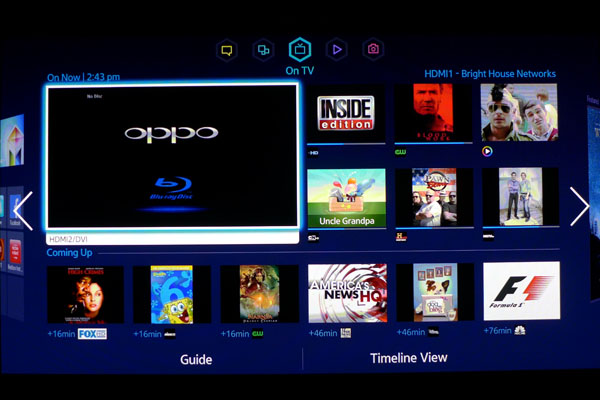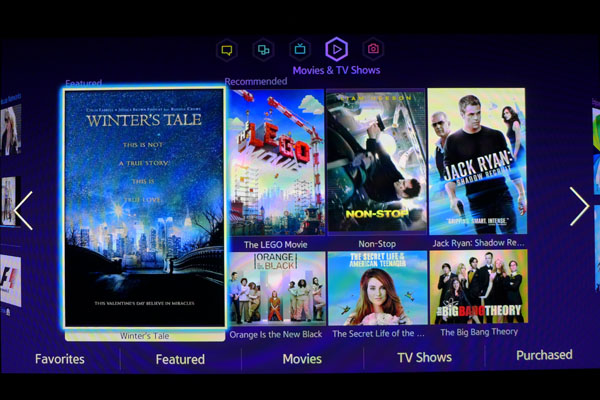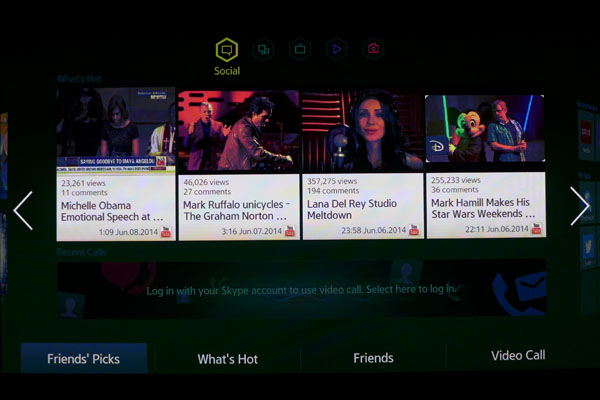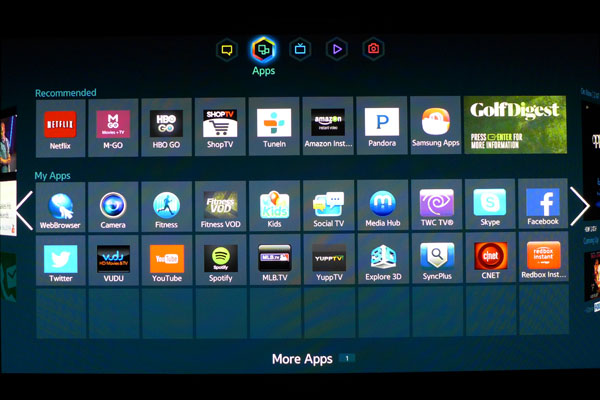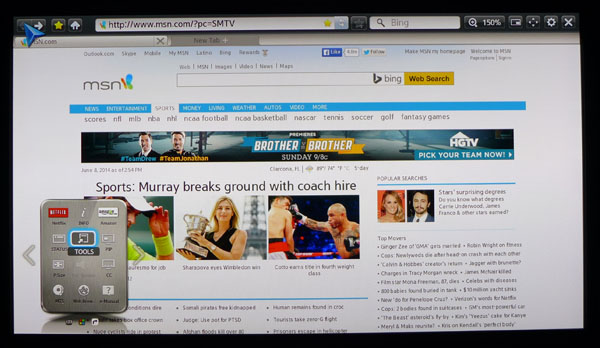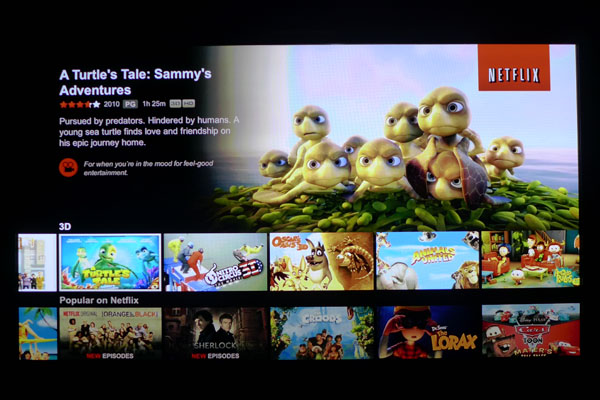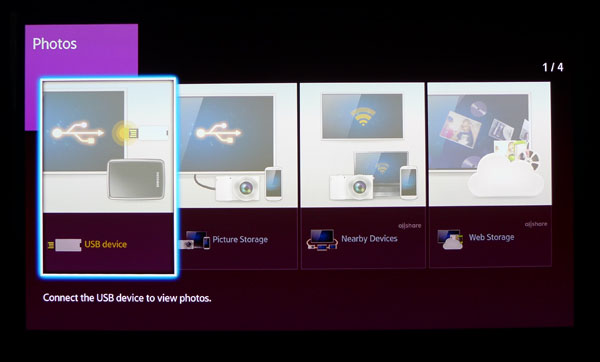Samsung PN51F8500 Review: A 51-Inch Plasma HDTV With SmartHub
Only two companies still make plasma TVs, so we’re excited to check out Samsung’s latest, the PN51F8500. It boasts 3D, SmartHub 2.0, and superb image quality. In the vast ocean of LCD televisions, it’s a compelling choice. Our lab results show you why.
Real-World Testing: SmartHub
Samsung has been in the smart TV game for a while, and the refinement that comes with experience really shows in its second-gen implementation. The interface runs through a 1.35 GHz quad-core processor and is very responsive, both to the remote and when pulling in content from the cloud.
Pressing the SmartHub button on the controller brings up a program guide that’s based on your local cable or satellite service. When I set it up, I had to enter my zip code and the name of my provider, Bright House.
In the upper-left, you can see the image from the active input (in this case, it’s an Oppo Blu-ray player). The thumbnails represent featured programming and upcoming shows. If you use a cable or satellite receiver, they're largely redundant and you don't have access to DVR functions or on-demand content from your carrier.
Swiping to the right takes you to a screen where you can buy or rent movies from Samsung or services like Vudu.
If you have a Vudu account, you can purchase 1080p content with up to 7.1-channel surround sound. This is an easy way to browse without starting up a separate app like you would with Netflix or Amazon, for example.
The next screen is the social media center. The photo shows a YouTube feed, but you can also interact with Facebook and Twitter. It’s easy to make Skype video calls using the F8500’s built-in camera and microphone. The only requirement is that you link your various accounts to Samsung first. Then you can access them right from the SmartHub.
SmartHub ships with a large suite of apps. Of course, you can download even more from Samsung if you want. Many of them offer direct access to sports and news feeds, as well as popular services like Instagram amd Amazon shopping.
Get Tom's Hardware's best news and in-depth reviews, straight to your inbox.
Naturally, there's a fully-functional Web browser built-in. I used it with the remote, though a Bluetooth-attached keyboard and mouse would likely be even easier. In the lower-left corner is a small Tools menu that pops up with a remote key. It gives you direct access to resources like Netflix and Amazon, as well as menu functions like screen size and picture mode.
Here’s the familiar Netflix interface. I was able to log in quickly, browse content in my queue, and use the search function. Thanks to the quad-core processor, it’s extremely responsive to remote commands. Content loads expediently, and the picture quality was excellent with few compression artifacts.
Samsung includes a gateway to locally-stored content in the SmartHub. You can browse the files on devices connected via USB, HDMI/MHL, WiDi, or the cloud (that can be a local NAS device or something from an Internet resource). File format support is quite extensive, including nearly every video, photo, and music codec in use today. If you have a home-based media server, you won’t need a separate bridge device to bring your content to the screen. SmartHub 2.0 seems to cover all of the bases.
Current page: Real-World Testing: SmartHub
Prev Page Real-World Testing: Movies and 3D Next Page Measurement And Calibration Methodology: How We Test
Christian Eberle is a Contributing Editor for Tom's Hardware US. He's a veteran reviewer of A/V equipment, specializing in monitors. Christian began his obsession with tech when he built his first PC in 1991, a 286 running DOS 3.0 at a blazing 12MHz. In 2006, he undertook training from the Imaging Science Foundation in video calibration and testing and thus started a passion for precise imaging that persists to this day. He is also a professional musician with a degree from the New England Conservatory as a classical bassoonist which he used to good effect as a performer with the West Point Army Band from 1987 to 2013. He enjoys watching movies and listening to high-end audio in his custom-built home theater and can be seen riding trails near his home on a race-ready ICE VTX recumbent trike. Christian enjoys the endless summer in Florida where he lives with his wife and Chihuahua and plays with orchestras around the state.
-
Nuckles_56 People still buy plasma screened TV's? I thought they went out like the floppy disk...Reply -
Merry_Blind Damn Samsung TVs have so much lag... They have amazing picture quality, but aren't fast enough for proper gaming... sigh... bring on the OLED!!!Reply -
n3cw4rr10r Am I the only one who thinks this is overpriced? especially with 4k TVs getting close to this range (Vizio P series will be out soon for $1000).Reply -
n3cw4rr10r Am I the only one who thinks this is overpriced? especially with 4k TVs getting close to this range (Vizio P series will be out soon for $1000).Reply -
colson79 It is such a shame everyone bailed on Plasma TV's, I still have one and the picture quality blows away LCD in the home theater. Hopefully my Plasma will last until OLED is reasonable. It would suck having to go to LCD.Reply -
jkhoward I love the quality of Plasma TV's.. I truly hope they keep developing this technology.Reply -
DisplayJunkie @Nuckles_56 your level of ignorance is astronomical yet not uncommon; you are making a fool of yourself.Reply
@n3cw4rr10r It's not overpriced at all, but rather an outstanding value (though not as good a value as the sorely-missed Panasonic P50ST60). The image quality is tremendously better than any 4K TV, even with perfect 4K source content, even if they sold the 4K TVs for $1500 or less. The difference in contrast(dynamic range) is the most important, and it is huge. Side-by-side with the plasma, no one would pick any 4K LCD. -
nthreem It's worth noting that Samsung announced it will discontinue production of plasmas at the end of the year. Better pick one up soon!Reply
I got a Panasonic VT60 at the beginning of the year, just as stock was running dry. I'm still amazed by the picture quality. -
Nintendo Maniac 64 ReplyHopefully my Plasma will last until OLED is reasonable.
Actually OLED is arguably already there or getting there. Some people were able to pick up LG's 55" OLED TV for $2000 (not a typo) via in-store at Microcenter.
For a more universal price-point, it's newest revision is now going for $3500. -
photonboy ReplyDamn Samsung TVs have so much lag... They have amazing picture quality, but aren't fast enough for proper gaming... sigh... bring on the OLED!!!
Most HDTV's have a "GAMING MODE" option which disables video processing inside the HDTV for a particular HDMI input such as your game console might use.
Having said that, burn-in issues have never been completely solved so I wouldn't game on a Plasma anyway (seems an important thing to mention doesn't it?).
